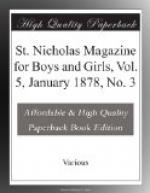“What shall we do?” said Fred.
“Let’s go into the garret!” exclaimed Harry.
This plan evidently suited both of them, for they made a rush toward the door; and the dog, awakening from his nap, entered into the idea, too.
At this moment, Aunt Carrie came into the room. They wished it had been grandmamma, for she never laid the least restriction on their sports, but smiled on every request and allowed them to do exactly as they pleased.
“Now, boys,” said Aunt Carrie, “where are you going?”
“Only into the garret, auntie.”
“Be sure to leave things exactly as you find them,” she replied, with a laugh and a little groan.
“We always do, Aunt Carrie.”
Away they went, with Gyp at their heels, and every footstep resounded through the old house until they reached the upper floor.
“It is no wonder that garret is never in order,” said Aunt Carrie; “but the children must enjoy themselves.”
“Of course, they must, Carrie,” replied grandma from the depths of her heart.
First, the boys pulled out a box of old books and papers, and busied themselves reading the queer names and advertisements of old times. Soon they turned from these to a shelf of chemical instruments. Most of them were in perfect order, and they knew they must keep their hands off, for the bulbs and tubes of glass were too delicate to be touched by unskilled fingers.
“Here is an old broken forrometer,” exclaimed Harry. “Let’s ask grandpa if we can have it.”
“You mean thermometer, don’t you?” said Fred. “What can we do with that?”
“Don’t you see? There is a great deal of quicksilver in this glass ball, and we can play with it. I’ll show you how.” And away they went downstairs to find their grandfather.
“Grandpa, can we have this?”
Mr. Lenox looked up from his newspaper.
“Let me see it a moment. What do you wish to do with it?”
“We will break it and take out the quicksilver, and then I will show you. Let me ask Ellen for a dish to catch the drops.”
“Not quite so fast; wait a moment, Harry,” replied Mr. Lenox. “I wish you to notice something about it first. The top of the tube is slightly broken, which makes it of no exact use, for to measure heat or cold the quicksilver must be entirely protected from the air. If you had noticed it when you first came in, you would see that the warmth of the room has caused it to rise in the tube. This is shown by the marks on the plate to which it is fastened. Now, if you hold it close to the stove, the quicksilver will rise still higher. Let it stand outside the window a moment, and it will sink.”
By this time the boys were much interested.
“But what makes it do so, grandpa?” they asked.
“Quicksilver is very sensitive to heat and cold. If the weather is warm, or if the room it is in is warm, it expands—swells out—and so rises in the glass tube, as you have seen. The least coolness in the air will cause it to contract, or draw itself into a smaller space; then, of course, it sinks in the tube.




